My recent fascination with mycology (the science of mushrooms, fungi, and slime molds) is only but an amplification of an interest I've had since I was a small child. Only recently have I actually made a strong effort to learn about these strange but beautiful organisms, when I finally grew sick and tired of just not know what that "strange mushroom" was that I would so often stumble upon on my nature outings.
July has been relatively moist for us this year, which is unusual when compared to recent years. And if it's one thing that mushrooms love, it's warm moisture!
A mushroom, as the living organism, lives underground. The visible body that we see is only but the breeding "fruit" of the organism that lives beneath the soil. In that regard, mushrooms of all types can be found year-round, but it is only at certain times of the year that the visible mushroom grows it's fleshy growth to disperse spores for future generations.
Father and I took a hike down into the stream bottom hollow that we, as a family, traditionally hunt in. The stream is small, bearing small minnows, frogs, and other creatures, and generally by this time of year a lack of rain has reduced it to a mere trickle, with stained and stagnant pools of water. This year has been different however, with plenty of summer rains feeding the stream, and keeping it flowing and healthy.
The most common tree, without a doubt along the stream at the bottom of the hollow is the Eastern Hemlock, Pennsylvania's state tree. The eastern hemlock is an evergreen, with short roundish needles, and rough bark. As the tree grows, the bottom branches die, leaving sharp, dead 'daggers' just under the living branches. As it turns out, many mushrooms grow best under hemlocks.
The next example is no exception. 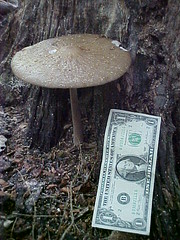
With a cap that was 6 inches in diameter (see the dollar placed for size comparison), this is one of the mushrooms my father spotted, tucked between the roots of a hemlock. A long thin stem revealed a long orange "dagger" when pulled from the earth. The top was smooth, slightly wrinkled near the center, and covered in a thin dust of hemlock wood. I thought it was pretty cool.
A crucial part of identifying a mushroom is by the spore print. Lay the cap on a paper plate, or possibly a BLACK piece of paper, wait over night before lifting the cap. Afterwards you will notice a print in the shape of the gills, and in this case, the print was almost as white as the paper plate! I'm currently working on IDing this mushie, although I think I might have an idea.
Another interesting mushroom we came across during our outing was one known as "turkey tail".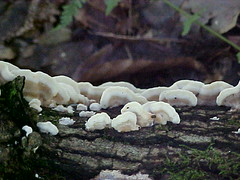
I have stumbled upon turkey tail more times than I can remember, but this is the first time I ran into THIS color variety with the knowledge of what species it was. The name is pretty obvious, as the fanned mushroom has a pattern of striping and color similar to that of the wild turkey.
The next mushroom smelled like a rotting carcass.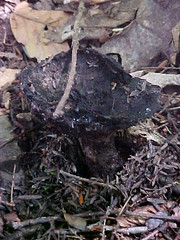
Bursting from the soil underneath the immense hemlocks, I couldn't even bare the thought of tossing this specimen in my bag. His black rotting flesh stunk so bad, I quickly threw him down, after a smelly slime stained my fingers. ICK! I'm thinkin that the species was not originally black, but only turned black and stinky as it began to rot!
Ahh...this is much better: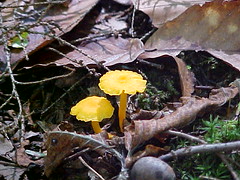
These small mushrooms were quite simply, among the most beautiful on the outing. They looked tubular, and the cap reminded me a lot of flower petals. Still no ID for this mushroom, but I'm working on it.
Just then, I stumbled upon a log that was COVERED in a strange white (what appeared to be) coral! Honestly, it almost looked like this dead tree had been pulled from the depths of the ocean, as it was covered in a coral-mushroom known as ramaria.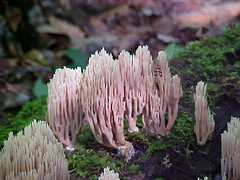
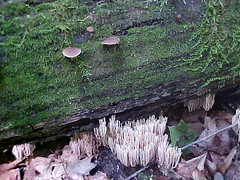
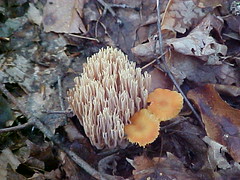
Ramaria is beautiful. Not sure on it's edibility, but even if it were edible, it's definitely not in the ranks of the "foolproof four", so I'll pass!
Ramaria is just one of many coral mushrooms that I found on this outing. The other was yellow coral: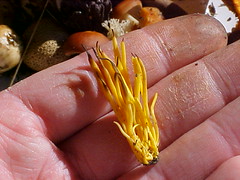
...not to be confused with Yellow Spindle Coral: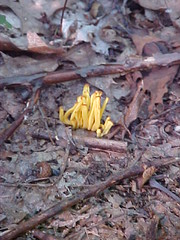
This coral mushroom looked different from ramaria, but I'm unsure of the species. I believe it's "Crested Coral":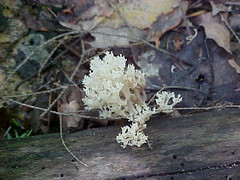
Close examination of a piece of hemlock bark revealed a strange pin-wheel like mushroom that closely resembled an parasol, with a thin black hair-like stem.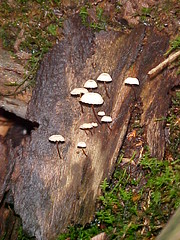
I identified this strange little guy as Marasmius rotula, or also known as Pinwheel Marasmius. Let's just call him pinwheel, shall we?
Then we have this beautiful mushroom: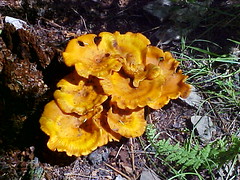
I have seen it before, I think I've even seen the name, but I'll be damned if I can find it now! GRRR!
Not long after the trip started, it ended, and I quickly took my bag full of mushrooms home, and set them on paper plates to identify them. All in all, a great day of learning!
My findings, compiled to paper plates: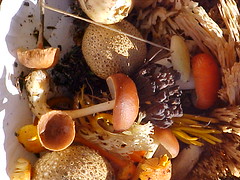
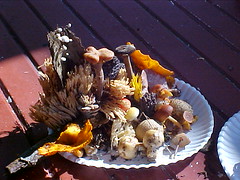
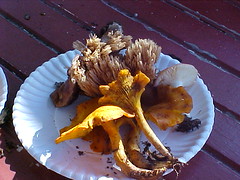
Until next time...
Friday, July 28, 2006
Bizarre Specimens
Posted by
Michael
at
12:43 PM
![]()
Subscribe to:
Comment Feed (RSS)




|